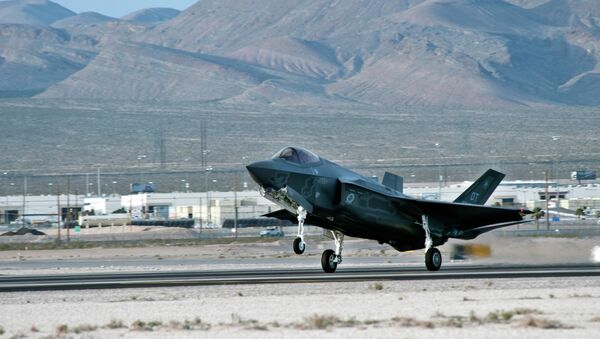The F-35B Lightning II Joint Strike Fighter — hailed as "hugely impressive" by Defense Secretary Michael Fallon — produced by US defense giant Lockheed Martin, is the most expensive weapons system in military history.
The "fifth generation" jet fighter has stealth capabilities, advanced networked electronics for situational awareness and low-probability intercept radar, among other gadgetry. It can fly at a maximum altitude of 15 kilometers, and reach speeds of Mach 1.6.
Prices range between US$100 million (£77million) and US$130 million (£100 million) per plane.
The UK has pledged to spend over US$15 billion (£12 billion) on the jets and aircraft carriers by 2021 — in all, it will buy 138 F-35s. The first squadron will arrive at RAF Marham in Norfolk next year.
The reasons are manifold. For one, sweeping defense cuts pursued by the ruling Conservative government mean other machinery in the UK military arsenal is ill-equipped to receive data from the "world's technologically advanced plane" — meaning they must be improved, lest the stealth jet's communications are intercepted by enemy forces.
The financial feasibility of an upgrade is highly questionable, given the military department responsible for computer networks essential to the aircraft's operation needs to make savings of over US$500 million in 2017.
Attendees at #RIAT17 had a chance to check out the #F35 full scale model. Learn about the F-35 for the UK: https://t.co/icg5sfYhwB pic.twitter.com/18EfEmHK6P
— F-35 Lightning II (@thef35) July 17, 2017
Moreover, the collapse in the value of sterling against the US dollar since the June 23, 2016 Brexit referendum is also likely to greatly bloat the UK's final bill in any event.
However, despite the plane's alleged technological primacy, some fear the F-35B's software system could be susceptible to cyberattack from foreign powers. The first tranche of 48 F-35Bs to be purchased will be the same sort the US was forced to ground in June due to software glitches.
In a statement, the Ministry of Defense said the F-35B Lightning II aircraft purchase program was "on time and within costs." The Ministry added all the issues raised by critics were reported in the past and were under "active management" — and claimed it did not recognise the mooted extra expenditure figures.
Defence Secretary Sir Michael Fallon announces a £135million contract to support the incoming F35's at RAF Marham https://t.co/UGGPoDGPbm pic.twitter.com/1TagzIEAlR
— Ministry of Defence (@DefenceHQ) June 21, 2017
The UK is not the only country that has taken an interest in the F-35B — Australia, the Netherlands and Norway are all testing the plane as of July 2017.
If critics' claims are accurate, it delivers another blow to the UK's Queen Elizabeth-class aircraft carrier ambitions. Plans for the carriers — the HMS Queen Elizabeth and HMS Prince of Wales — date back to 1997, when Tony Blair's Labour government published a report highlighting the urgent need for Britain to regain its aircraft carrier capabilities, lacking since 1966.
However, it took until 2007 for a contract for the vessels to be announced, and another year for it to be awarded (to BVT Surface Fleet, a merger of BAE Systems Surface Fleet Solutions and VT Group's VT Shipbuilding). Once complete, they will be the largest warships ever built in the UK.
Nonetheless, uncertainty surrounded the project for almost a decade subsequently, with serious concerns over spiralling costs and operability leading some analysts to suggest the project may never be completed.
In 2013, then-Defense Secretary Philip Hammond announced the vessels would cost over US$8 billion (£6.2 billion) to complete. With the ships scheduled to be finally launched onto the seas before the end of 2017, it may be the UK government is willing to overlook budgetary and technological issues to ensure the pair are seafaring by the stated deadline.




